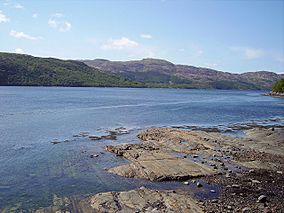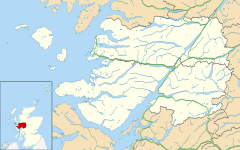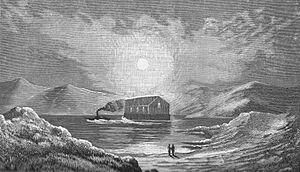Loch Sunart facts for kids
Quick facts for kids Loch Sunart MPA |
|
|---|---|
|
IUCN Category IV (Habitat/Species Management Area)
|
|

Looking south over Loch Sunart to Morvern
|
|
| Location | Lochaber, Scotland |
| Area | 4,900 ha (19 sq mi) |
| Designation | Scottish Government |
| Established | 2014 |
| Operator | Marine Scotland |
Loch Sunart (which means Loch Shuaineart in Scottish Gaelic) is a long, narrow arm of the sea, also known as a sea loch, located on the west coast of Scotland. It stretches for about 31 kilometers (19 miles), making it the longest sea loch in the Highland region. To the north, it's bordered by the Sunart area of Ardnamurchan, and to the south, by the Morvern area.
The deepest part of Loch Sunart is about 124 meters (407 feet) deep. This deep spot is found east of Càrna island, near the entrance to another smaller loch called Loch Teacuis. Several islands dot the loch, including Oronsay, Risga, and Eilean Mòr.
Contents
Life in the Loch
Loch Sunart is home to many interesting sea creatures and plants. Because of its special environment, a large part of the loch has been set aside as a protected area.
Protecting Marine Life
In 2014, the entire loch, covering an area of 49 square kilometers (19 square miles), was named a Nature Conservation Marine Protected Area (NCMPA). This was done to protect important habitats and species found here.
Special Species in the Loch
- Flame Shell Beds: These are special areas where many flame shells (Limaria hians) live. They create nests that provide homes for other small creatures.
- Serpulid Beds: These are beds formed by tube worms called serpulids. They build hard tubes that attach to the seabed, creating unique structures.
- Celtic Feather Stars: A population of Leptometra celtica, a type of feather star, also lives here.
- Other Animals: You can also find various sponges, starfish, and brittlestars in the loch.
The Loch Sunart protected area is managed to keep its natural features safe. Generally, certain types of fishing gear are not allowed here, but creeling (using traps for shellfish) is permitted in some parts of the loch.
Wider Protected Area
Loch Sunart is also part of an even larger protected area called the Loch Sunart to the Sound of Jura. This bigger area covers about 741 square kilometers (286 square miles) and includes the Sound of Mull, the Firth of Lorne, and the Sound of Jura. This larger MPA helps protect:
- Common Skate: A type of large ray.
- Quaternary Geological Features: These are special rock formations and landforms from the most recent geological period.
Local Stories and History
The Legend of the Swans
There's a local legend that explains why you don't see many swans living permanently in Loch Sunart. The story tells of a Celtic chieftain and a local girl who fell in love. The chieftain's mother didn't approve of their marriage. To stop them, she used magic to turn the girl into a swan. Sadly, the young man later went hunting and accidentally killed the swan, not knowing it was his beloved. When he found out the truth, he was so heartbroken that he took his own life to join her at the bottom of the loch. The legend says that swans have avoided living in Loch Sunart ever since.
The Floating Iron Church
In the 1840s, there was a time of big changes in the church in Scotland, known as the Disruption. In the Loch Sunart area, the local landlord refused to let the Free Church build a church on his land.
To solve this problem, a man named Graham Speirs came up with a clever idea: he decided to build a floating church made of iron! This unique church was finished and towed into Loch Sunart on July 8, 1846. It was safely moored about 150 yards offshore in a bay near Ardnastang. On the first Sunday, people were ferried out to the church between ten in the morning and noon for public worship. A large blue flag flew from the church, with the words "An Eaglais Shaor" (The Free Church) written on it.
Aquaculture in the Loch
A significant part of Loch Sunart is used for aquaculture, which is like farming in the sea. Since the 1980s, fish farming has been established here. Originally, these farms mainly raised salmon, but over time, they have started to raise other types of fish as well.




